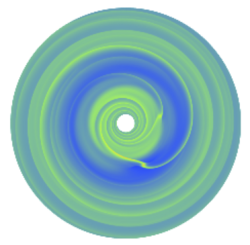Astronomy:HD 45364
| Observation data Equinox J2000.0]] (ICRS) | |
|---|---|
| Constellation | Canis Major |
| Right ascension | 06h 25m 38.47443s[1] |
| Declination | −31° 28′ 51.4285″[1] |
| Apparent magnitude (V) | 8.08[2] |
| Characteristics | |
| Spectral type | G8V[3] |
| B−V color index | 0.719±0.015[2] |
| V−R color index | 0.01 |
| Astrometry | |
| Radial velocity (Rv) | +16.392±0.0004[1] km/s |
| Proper motion (μ) | RA: +52.182[1] mas/yr Dec.: −11.926[1] mas/yr |
| Parallax (π) | 29.0797 ± 0.0316[1] mas |
| Distance | 112.2 ± 0.1 ly (34.39 ± 0.04 pc) |
| Absolute magnitude (MV) | +5.51[2] |
| Details[4] | |
| Mass | 0.88±0.02 M☉ |
| Radius | 0.82±0.01 R☉ |
| Luminosity | 0.562±0.004 L☉ |
| Surface gravity (log g) | 4.55±0.03 cgs |
| Temperature | 5,540±31 K |
| Metallicity [Fe/H] | −0.14±0.03[2] dex |
| Rotational velocity (v sin i) | 1.672±0.665[5] km/s |
| Age | 3.4±2.7 Gyr |
| Other designations | |
| Database references | |
| SIMBAD | data |
| Exoplanet Archive | data |
| Extrasolar Planets Encyclopaedia | data |
HD 45364 is a star in the southern constellation of Canis Major. It is too faint to be visible to the naked eye, having an apparent visual magnitude of 8.08.[2] The distance to this system is 112 light years based on parallax.[1] It is drifting further away from the Sun with a radial velocity of +16.4 km/s,[1] having come within 49 light-years some 1.5 million years ago.[2]
This object is an ordinary G-type main-sequence star with a stellar classification of G8V,[3] which indicates it is generating energy through core hydrogen fusion. It is around 3.4 billion years old and is spinning with a projected rotational velocity of 1.7 km/s.[5] The star has 88% of the mass of the Sun and 82% of the Sun's radius. It is radiating 56% of the luminosity of the Sun from its photosphere at an effective temperature of 5,540 K. As of August 2008 there are two confirmed extrasolar planets (or exoplanets) orbiting around it.[7]
Planetary system
HD 45364 is one of only a relative few systems that have had more than one exoplanet discovered in its orbit. The two planets, HD 45364 b and HD 45364 c respectively, were both discovered in August 2008 using the radial velocity method. The pair was initially believed to be orbiting the host star with a 3:2 mean motion resonance,[7] which means the inner planet is completing three orbits for every two orbits of the outer planet.
It was difficult to explain how such resonant configuration of planetary orbits could evolve,[8] mainly due to too high (4-5 times) orbital eccentrities, although planetary system formation models involving hydrodynamic effects were proposed.[9]
As in 2022, refined radial-velocity data shows the planetary orbits are more circular and widely spaced, therefore planets are slightly out of mean motion resonance state.[10]
| Companion (in order from star) |
Mass | Semimajor axis (AU) |
Orbital period (days) |
Eccentricity | Inclination | Radius |
|---|---|---|---|---|---|---|
| b | ≥0.1893+0.0062−0.006 MJ | 0.6793+0.0016−0.0015 | 225.79+0.81−0.76 | 0.067±0.016 | — | — |
| c | ≥0.5490+0.0075−0.0074 MJ | 0.9020±0.0010 | 345.43+0.54−0.57 | 0.019+0.011−0.010 | — | — |
References
- ↑ 1.0 1.1 1.2 1.3 1.4 1.5 1.6 1.7 Brown, A. G. A. (August 2018). "Gaia Data Release 2: Summary of the contents and survey properties". Astronomy & Astrophysics 616: A1. doi:10.1051/0004-6361/201833051. Bibcode: 2018A&A...616A...1G. Gaia DR2 record for this source at VizieR.
- ↑ 2.0 2.1 2.2 2.3 2.4 2.5 Anderson, E.; Francis, Ch. (2012). "XHIP: An extended hipparcos compilation". Astronomy Letters 38 (5): 331. doi:10.1134/S1063773712050015. Bibcode: 2012AstL...38..331A.
- ↑ 3.0 3.1 Gray, R. O. et al. (July 2006). "Contributions to the Nearby Stars (NStars) Project: spectroscopy of stars earlier than M0 within 40 pc-The Southern Sample". The Astronomical Journal 132 (1): 161–170. doi:10.1086/504637. Bibcode: 2006AJ....132..161G.
- ↑ Bonfanti, A. et al. (2015). "Revising the ages of planet-hosting stars". Astronomy and Astrophysics 575: A18. doi:10.1051/0004-6361/201424951. Bibcode: 2015A&A...575A..18B. http://www.aanda.org/articles/aa/full_html/2015/03/aa24951-14/aa24951-14.html.
- ↑ 5.0 5.1 Soto, M. G.; Jenkins, J. S. (July 2018). "Spectroscopic Parameters and atmosphEric ChemIstriEs of Stars (SPECIES). I. Code description and dwarf stars catalogue". Astronomy & Astrophysics 615: 28. doi:10.1051/0004-6361/201731533. A76. Bibcode: 2018A&A...615A..76S.
- ↑ "HD 45364". SIMBAD. Centre de données astronomiques de Strasbourg. http://simbad.u-strasbg.fr/simbad/sim-basic?Ident=HD+45364.
- ↑ 7.0 7.1 Correia, A. C. M. et al. (2009). "The HARPS search for southern extra-solar planets XVI. HD 45364, a pair of planets in a 3:2 mean motion resonance". Astronomy and Astrophysics 496 (2): 521–526. doi:10.1051/0004-6361:200810774. Bibcode: 2009A&A...496..521C. http://www.aanda.org/articles/aa/full_html/2009/11/aa10774-08/aa10774-08.html.
- ↑ Rein, H. et al. (2010). "The dynamical origin of the multi-planetary system HD 45364" (abstract). Astronomy and Astrophysics 510 (1): A4. doi:10.1051/0004-6361/200913208. Bibcode: 2010A&A...510A...4R. http://www.aanda.org/index.php?option=article&access=doi&doi=10.1051/0004-6361/200913208. (web preprint)
- ↑ Correa-Otto, J. (2013). "A new scenario for the origin of the 3/2 resonant system HD 45364". Astronomy and Astrophysics 560 (65): A65. doi:10.1051/0004-6361/201321917. Bibcode: 2013A&A...560A..65C. http://www.aanda.org/articles/aa/abs/2013/12/aa21917-13/aa21917-13.html.
- ↑ 10.0 10.1 Li, Zhexing; Kane, Stephen R.; Dalba, Paul A.; Howard, Andrew W.; Isaacson, Howard T. (2022), "New Dynamical State and Habitability of the HD 45364 Planetary System", The Astronomical Journal 164 (4): 163, doi:10.3847/1538-3881/ac8d63, Bibcode: 2022AJ....164..163L
Coordinates: ![]() 06h 25m 38s, −31° 28′ 51″
06h 25m 38s, −31° 28′ 51″
 |


